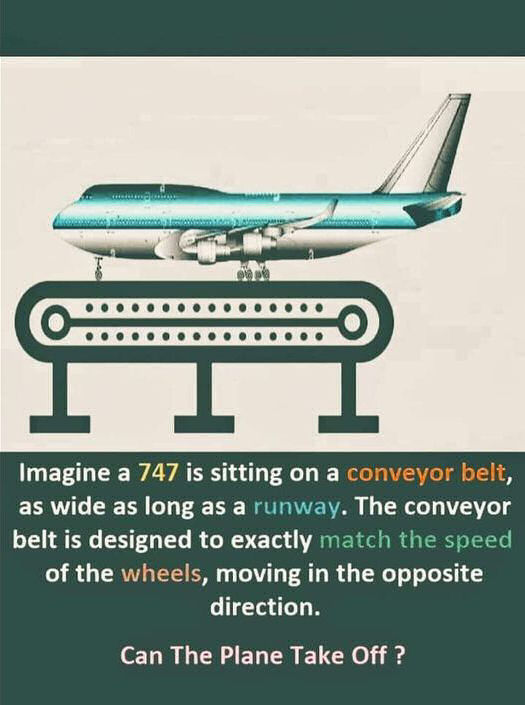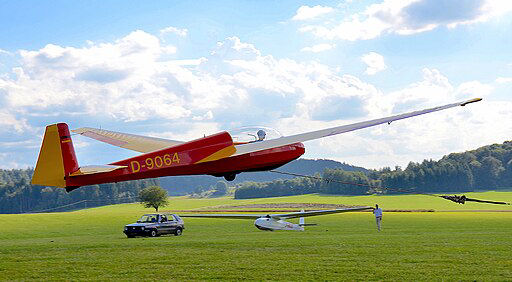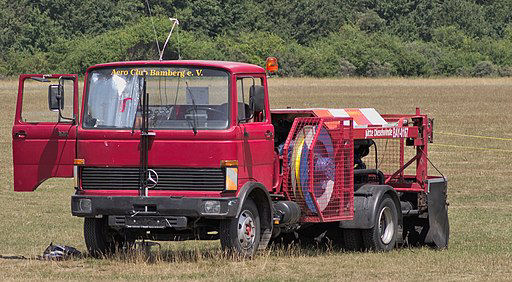This is a question that has been doing the rounds on Facebook recently and has generated a massive response with the vast majority of them being completely wrong or just plain stupid.
"Imagine a 747 is sitting on a conveyor belt as wide and as long as a runway. The conveyor belt is designed to exactly match the speed of the wheels, moving in the opposite direction.
Can the plane take off? "
The answer is most definitely yes, because the conveyor belt does not have any effect on the movement of the 747.
The biggest misunderstanding is that the 747 uses the ground, (runway or conveyor belt), to achieve forward motion to gain enough air speed to fly, it doesn't, it uses thrust from the engines.
Thrust is a reaction force described quantitatively by Newton's third law.
When a system expels or accelerates mass in one direction, the accelerated mass will cause a force of equal magnitude but opposite direction to be applied to that system

The 747 is being powered forwards by its engines and it does not matter if the conveyor belt is stationary, moving in the same direction as the 747 or moving in the opposite direction of the 747.
To better understand the logic of all of this I would like to explain how a glider (sailplane for the Americans) takes off as this will help explain why the 747 will take off.
A glider has no engine so it requires something to accelerate it to a speed that enables it to take off.
There are two common methods to launch a glider; one is an aero tow, the other a winch tow. Both of these methods use a long cable that is attached to the front of the glider.
The aero tow cable is attached to a powered airplane that pulls the glider along. The winch tow is attached to a winch on the ground to pull the glider along.
Once the glider has reached its minimum speed to get airborne, the glider pilot pulls the stick back and the glider lifts off.


A glider usually has one main wheel situated in the middle of the glider. When the tow cable starts to pull the glider, the glider starts to move. The wheel turns due to its contact with the ground and the friction between the tyre and the ground.
Just to make the maths easier to understand, we will assume that the wheel has a circumference of exactly 1 meter. So, when the glider is moving forward at 1 meter per second the wheel is turning at one revolution per second and of course when its moving forward at 10 meters per second the wheel is rotating at 10 revolutions per second and so on.
Now matching the original question, the glider is not sitting on a tarmac runway but a conveyor belt that is designed to exactly match the speed of the glider's wheel.
The tow cable starts to pull the glider and the wheel starts to turn and of course the conveyor belt also starts to turn in the opposite direction at exactly the same speed. So, when on tarmac the glider is moving at 1 meter per second the wheel is turning at 1 revolution per second, but now the conveyor is moving in the opposite direction at 1 meter per second.
The glider is still moving forward as its attached to a tow cable pulling it and is traveling at one meter per second. The ground if it was a tarmac runway would be moving underneath the glider at one meter per second but as it’s a conveyor moving in the opposite direction at the same speed (one meter per second) the difference is that the ground (the conveyor) is passing underneath the glider at two meters per second. The gliders forward movement is one meter per second and the conveyors backwards movement is one meter per second. They don’t subtract from each other they add.
I have used one meter per second to illustrate the principle but of course any speed will still give the same effect.
If the glider is moving forward at 1 millimetre per second, the conveyor will be moving backwards at 1 millimetre per second. If it were one micron per second it will still be the same effect. Why? Because the tow cable is pulling it, the tow cable pulling the glider is not affected in any way by the tarmac or the movement of conveyor. You could have the conveyor moving backwards at two or three or a hundred times the wheel speed of the glider, the glider would still be being pulled forward at one meter per second (or whatever speed the cable was pulling at), the only effect of the conveyor speed would be on the when speed of the glider, not the tow cable speed.
The difference for a powered airplane is that it has its own ability to move forward, it replaces the tow cable with an engine or engines, turbo prop or jet. The thrust that the engines produce is the tow cable; the thrust pushes the airplane forward.
If, as some people argue that the airplane will not take off because the backwards movement of the conveyor will negate the forward movement of the wheels, consider this, if the conveyor belt were to move in the same direction as the 747 wheels rather than the opposite direction, then the 747 would take off in a shorter distance. So if this arguement is true, then why has no one not designed a conveyor the moves in the same direction as the wheels but at 100 times faster, so the 747 could take off when it’s at 18.4 miles an hour instead of 184 mile an hour?
If you are still not convinced and you would like to share your thoughts please do get in touch.








